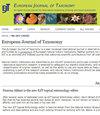奇怪的新蜘蛛:论Roddenberryus,一种新的和不寻常的蜘蛛属(蜘蛛目,蜘蛛科)
IF 1.1
3区 生物学
Q3 ENTOMOLOGY
引用次数: 0
摘要
新建立的nopine属Roddenberryus gen. 11 .共包括5种:哥斯达黎加的R. kirk gen. et sp. 11 .(雄性和雌性),墨西哥坎佩切的R. spock gen. et sp. 11 .(雌性),墨西哥下加利福尼亚州南部的R. mccoy gen. et sp. 11 .(雄性),以及之前在Caponina Simon的2种,即R. sargi (Pickard-Cambridge, 1899) gen. et comb。11月来自危地马拉和r.p elegrina (Bryant, 1940) gen. et comb。11月从古巴。e.k ritscher(1957)报告的哥斯达黎加的C. sargi Pickard-Cambridge雄性标本与在同一地点采集的一只雌性标本被分配给Roddenberryus kirk。新属的特点是远端投射的端尖和一个三角形的,投射的阴唇,一个独特的构象之间的nopines;也由一三角形的,非常短的,有鳞的剑鞘,小齿具散布的多齿行,和一跗骨器官具强烈突出的边缘。Roddenberryus和Tarsonops Chamberlin一样有开裂的跗骨和跖骨,有多个在角质层上缠绕的无骨关节和一个不寻常的内部呼吸系统,两个后气管融合在一个躯干上。本文章由计算机程序翻译,如有差异,请以英文原文为准。
Strange new spiders: on Roddenberryus, a new and unusual caponiid genus (Araneae, Caponiidae)
The new nopine genus Roddenberryus gen. nov. is erected to include in total five species: three new species, R. kirk gen. et sp. nov. (male and female) from Costa Rica, R. spock gen. et sp. nov. (female) from Campeche, Mexico and R. mccoy gen. et sp. nov. (male) from Baja California Sur, Mexico, as well as two species previously misplaced in Caponina Simon, i.e., R. sargi (Pickard-Cambridge, 1899) gen. et comb. nov. from Guatemala and R. pelegrina (Bryant, 1940) gen. et comb. nov. from Cuba. A male specimen reported as C. sargi Pickard-Cambridge from Costa Rica by E. Kritscher (1957) is assigned to Roddenberryus kirk together with one female collected at the same locality. The new genus is characterized by the distally projected endites and a triangular, projected labium, a conformation unique among nopines; also by a triangular, very short, scaly gladius, serrula with interspersed multiple tooth rows, and a tarsal organ with strongly projected margins. Roddenberryus shares with Tarsonops Chamberlin the cracked tarsi and metatarsi, with multiple adesmatic joints intertwined on the cuticle and an unusual internal respiratory system with both posterior tracheae fused in a single trunk.
求助全文
通过发布文献求助,成功后即可免费获取论文全文。
去求助
来源期刊

European journal of taxonomy
ZOOLOGY-
CiteScore
2.30
自引率
8.30%
发文量
173
审稿时长
29 weeks
期刊介绍:
EJT is a fully refereed, international, fully electronic Open Access journal in descriptive taxonomy, covering subjects in zoology, entomology, botany (in its broadest sense), and palaeontology. EJT-papers must be original and adhere to high scientific (content) and technical (language, artwork, etc.) standards. Manuscripts that are clearly substandard in either of these categories will not be sent out for review. EJT is supported by a consortium of European Natural History Institutes, but its scope is global. Both authorship and geographical region of study need not be European. Authors are, however, strongly encouraged to involve European Natural History collections by consulting material or by depositing specimens (e.g. types and figured material) related to their published paper in the collection of a European Natural History Institute.
 求助内容:
求助内容: 应助结果提醒方式:
应助结果提醒方式:


